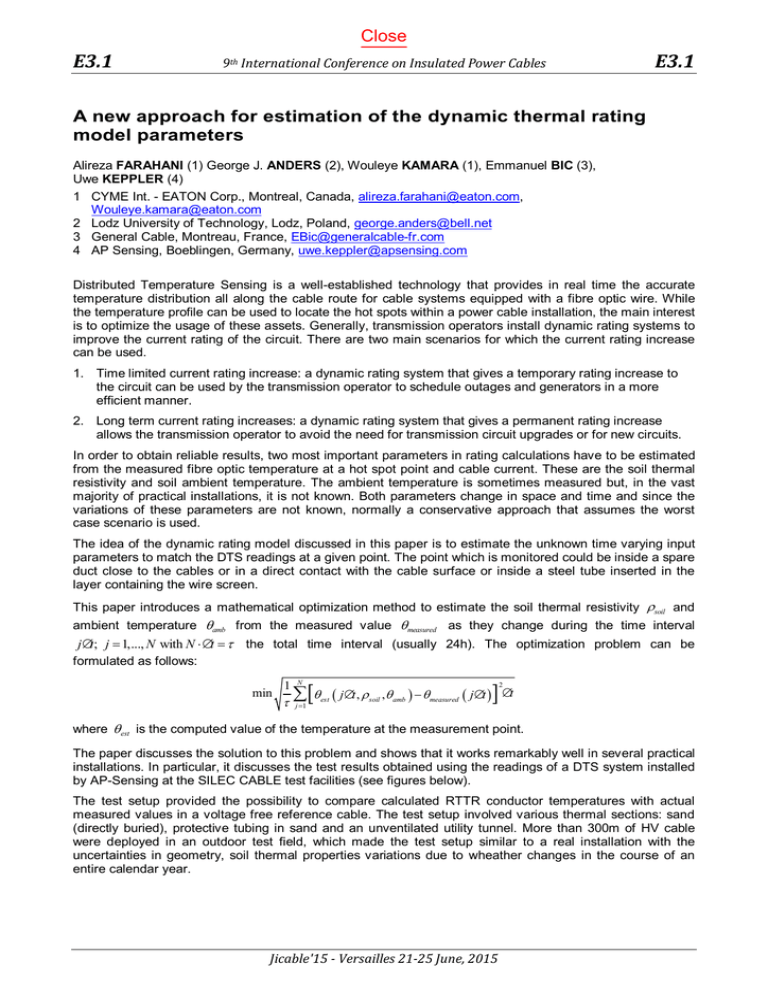E3.1 - Jicable
advertisement

Close E3.1 9th International Conference on Insulated Power Cables E3.1 A new approach for estimation of the dynamic thermal rating model parameters Alireza FARAHANI (1) George J. ANDERS (2), Wouleye KAMARA (1), Emmanuel BIC (3), Uwe KEPPLER (4) 1 CYME Int. - EATON Corp., Montreal, Canada, alireza.farahani@eaton.com, Wouleye.kamara@eaton.com 2 Lodz University of Technology, Lodz, Poland, george.anders@bell.net 3 General Cable, Montreau, France, EBic@generalcable-fr.com 4 AP Sensing, Boeblingen, Germany, uwe.keppler@apsensing.com Distributed Temperature Sensing is a well-established technology that provides in real time the accurate temperature distribution all along the cable route for cable systems equipped with a fibre optic wire. While the temperature profile can be used to locate the hot spots within a power cable installation, the main interest is to optimize the usage of these assets. Generally, transmission operators install dynamic rating systems to improve the current rating of the circuit. There are two main scenarios for which the current rating increase can be used. 1. Time limited current rating increase: a dynamic rating system that gives a temporary rating increase to the circuit can be used by the transmission operator to schedule outages and generators in a more efficient manner. 2. Long term current rating increases: a dynamic rating system that gives a permanent rating increase allows the transmission operator to avoid the need for transmission circuit upgrades or for new circuits. In order to obtain reliable results, two most important parameters in rating calculations have to be estimated from the measured fibre optic temperature at a hot spot point and cable current. These are the soil thermal resistivity and soil ambient temperature. The ambient temperature is sometimes measured but, in the vast majority of practical installations, it is not known. Both parameters change in space and time and since the variations of these parameters are not known, normally a conservative approach that assumes the worst case scenario is used. The idea of the dynamic rating model discussed in this paper is to estimate the unknown time varying input parameters to match the DTS readings at a given point. The point which is monitored could be inside a spare duct close to the cables or in a direct contact with the cable surface or inside a steel tube inserted in the layer containing the wire screen. This paper introduces a mathematical optimization method to estimate the soil thermal resistivity ρsoil and ambient temperature θamb from the measured value θmeasured as they change during the time interval j ∆t; j = 1,..., N with N ⋅∆t = τ formulated as follows: the total time interval (usually 24h). The optimization problem can be min ∑[θ ( j∆t , ρ τ 1 N j =1 est soil ] 2 , θ amb ) − θmeasured ( j ∆t ) ∆t where θ est is the computed value of the temperature at the measurement point. The paper discusses the solution to this problem and shows that it works remarkably well in several practical installations. In particular, it discusses the test results obtained using the readings of a DTS system installed by AP-Sensing at the SILEC CABLE test facilities (see figures below). The test setup provided the possibility to compare calculated RTTR conductor temperatures with actual measured values in a voltage free reference cable. The test setup involved various thermal sections: sand (directly buried), protective tubing in sand and an unventilated utility tunnel. More than 300m of HV cable were deployed in an outdoor test field, which made the test setup similar to a real installation with the uncertainties in geometry, soil thermal properties variations due to wheather changes in the course of an entire calendar year. Jicable'15 - Versailles 21-25 June, 2015 Close E3.1 9th International Conference on Insulated Power Cables Fig. 1 Fig. 2 Jicable'15 - Versailles 21-25 June, 2015 E3.1
